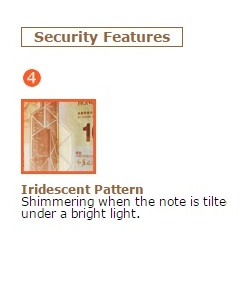
The Mahatma Gandhi Series of banknotes contain the Mahatma Gandhi watermark with a light and shade effect and multi-directional lines in the watermark window.
Security Thread
Rs.1000 notes introduced in October 2000 contain a readable, windowed security thread alternately visible on the
obverse with the inscriptions ‘Bharat’ (in Hindi), ‘1000’ and ‘RBI’, but totally embedded on the reverse. The Rs.500 and Rs.100 notes have a security thread with similar visible features and inscription ‘Bharat’ (in Hindi), and ‘RBI’. When held against the light, the security thread on Rs.1000, Rs.500 and Rs.100 can be seen as one continuous line. The Rs.5, Rs.10, Rs.20 and Rs.50 notes contain a readable, fully embedded windowed security thread with the inscription ‘Bharat’ (in Hindi), and ‘RBI’. The security thread appears to the left of the Mahatma's portrait. Notes issued prior to the introduction of the Mahatma Gandhi Series have a plain, non-readable fully embedded security thread.
Latent Image

On the obverse side of Rs.1000, Rs.500, Rs.100, Rs.50 and Rs.20 notes, a vertical band on the right side of the Mahatma Gandhi’s portrait contains a latent image showing the respective denominational value in numeral. The latent image is visible only when the note is held horizontally at eye level.
Microlettering
 This feature appears between the vertical band and Mahatma Gandhi portrait. It contains the word ‘RBI’ in Rs.5 and Rs.10. The notes of Rs.20 and above also contain the denominational value of the notes in microletters. This feature can be seen better under a magnifying glass.
This feature appears between the vertical band and Mahatma Gandhi portrait. It contains the word ‘RBI’ in Rs.5 and Rs.10. The notes of Rs.20 and above also contain the denominational value of the notes in microletters. This feature can be seen better under a magnifying glass.
Intaglio Printing
The portrait of Mahatma Gandhi, the Reserve Bank seal, guarantee and promise clause, Ashoka Pillar Emblem on the left, RBI Governor's signature are printed in intaglio i.e. in raised prints, which can be felt by touch, in Rs.20, Rs.50, Rs.100, Rs.500 and Rs.1000 notes.
A special feature in intaglio has been introduced on the left of the watermark window on all notes except Rs.10/- note. This feature is in different shapes for various denominations (Rs. 20-Vertical Rectangle, Rs.50-Square, Rs.100-Triangle, Rs.500-Circle, Rs.1000-Diamond) and helps the visually impaired to identify the denomination.
Number panels of the notes are printed in fluorescent ink. The notes also have optical fibres. Both can be seen when the notes are exposed to ultra-violet lamp.
This is a new security feature incorporated in the Rs.1000 and Rs.500 notes with revised colour scheme introduced in November 2000. The numeral 1000 and 500 on the obverse of Rs.1000 and Rs.500 notes respectively is printed in optically variable ink viz., a colour-shifting ink. The colour of the numeral 1000/500 appears green when the note is held flat but would change to blue when the note is held at an angle.
The small floral design printed both on the front (hollow) and back (filled up) of the note in the middle of the vertical band next to the Watermark has an accurate back to back registration. The design will appear as one floral design when seen against the light.
Legal provisions against counterfeiting
Printing and circulation of forged notes are offences under Sections 489A to 489E of the Indian Penal Code and are punishable in the courts of law by fine or imprisonment or both.
धन्यवाद/dhanyavaad/thank you



















































